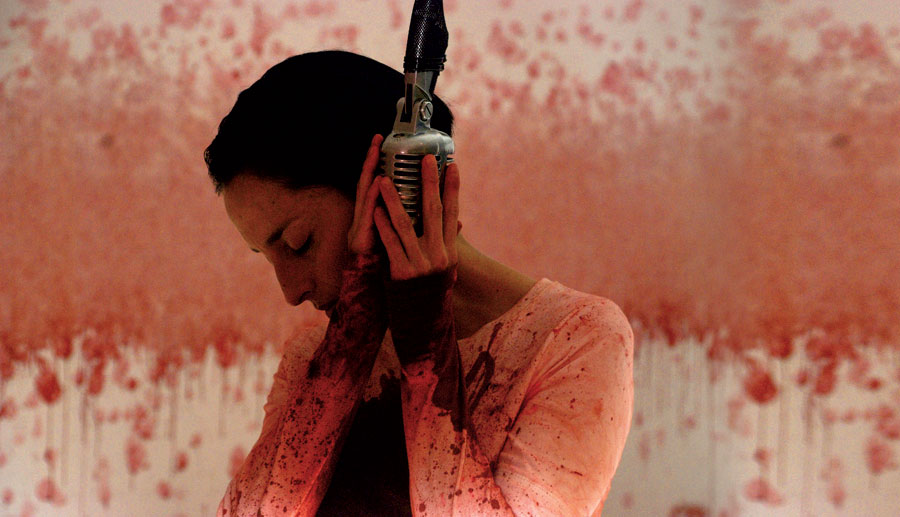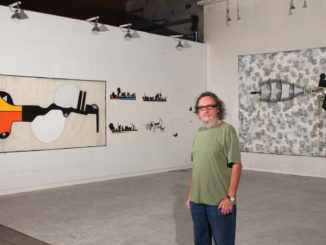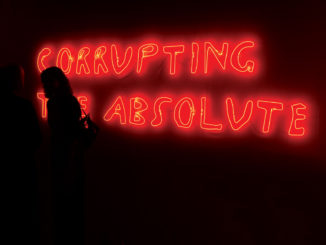
The most appropriate way to answer an inquiry may probably be formulating a question. One would avoid so many uncomfortable situations like blushing, getting nervous, or (worse) acting as if not finding an intelligent response was not important. “Are you happy?” someone asked me not too long ago, and I didn’t know what to say. But not all questions are there to be answered. In fact, some of them merely exist for us to understand certain things, to have a clearer perception on the lives we’re living. And yet, one simple question may have such an impact on people that it becomes a catalyst, helping us to take radical decisions that are long overdue. That’s the power of words.
Karaoke by Maria Jose Arjona produces a similar effect on the viewers. Conceived as part of a more extended series, Arjona’s performance challenges the spectator’s idea of karaoke as mere entertainment. The artist draws us into a secret, passionate love story by performing Edith Piaf’s famous song “Non Je Ne Regrette Rien.” The lyrics are projected on a wall while she stands, accompanied by three hanging microphones, in the center of the gallery. Maria Jose wears a white wedding dress with suspicious red stains on it. Sequels from her previous performances are intentionally visible, increasing the dramatic strength of the piece. Did she kill a man, a woman, from her past? Did she kill herself, her ghosts and memories? Why does she repeat the same song over and over again? Who’ll have to use the two extra microphones on display?
The red stains (of blood?) on the artist’s dress represent the idea of murder. It is never said who the victim is, but we do know that something or someone has actually died. It could be a real person – a lover, perhaps -, bad memories, or a regretful feeling. Here the spectator plays the role of the detective, trying to figure out the real cause of the assassination. The performer (supposed killer), however, inspires pity and compassion. Despite of being surrounded by a great number of people, the artist has never felt so lonely and vulnerable. Even the warmest looks seem strange, unfamiliar to her, for they are painfully inquiring and curious. Viewers drink beer and take detailed notes on the artist’s moves so as to get to the heart of the homicide. They work on hypothetical view points, conjectures, and refutations. The more they search, the more they get frustrated. The actual truth is still to be found.
Maria Jose sings for three consecutive hours until her voice shuts down completely. Edith Piaf’s song becomes her vindication. At last, the artist confesses her crime: she has killed her memories. The performer somehow reminds of Charlotte Corday, the beautiful young lady who stabbed Swiss-born French politician Jean-Paul Marat in his bathtub. As per Corday’s belief, Marat represented a serious threat to the Republic, and therefore his death would bring peace across the nation. Before being executed under the guillotine, Corday stated at her trial “I killed one man to save 100,000.” Likewise, the artist doesn’t feel sorry or disappointed with her actions. This was not a hazardous crime but a necessary, well-premeditated one. The killer needed to kill in self-defense so that she could look at her past with no hard feelings. Piaf’s words reverberate in our ears, and suddenly we are not the artist’s “judges” anymore. By confessing the true nature and reasons for her crime, the killer makes us her most devoted accomplices.
But, is she the only murderer in the room? Are there any other killers camouflaged among the public? Indeed, the two extra microphones remain open during the whole night for those who need to confess either their criminal instincts or succeeded crimes. The artist invites the viewers to sing along with her. It’s time to end up with the ever-lasting masquerade. Who has the courage to get through the dangerous fourth wall raised inside oneself for years? Not too many, of course. Nobody wants to be the first. Viewers move from side to side, hide behind glasses full of champagne or leave the gallery, in hopes of avoiding being exposed in front of their jury. The killer we look forward to finding is not the artist anymore. He is each of us, and we are afraid to reveal it. Why are we so frightened to come across, burn images from a past that asphyxiates us? Have we never had the crazy idea of shooting –bowls, cans, intruders- even if that killing happens at a metaphorical level? Maria Jose Arjona makes the spectators break away from their comfort zones. Are we still capable of love? Karaoke turns into a sort of an exorcism ceremony where both artist and viewers confront their fears of a new beginning.



Be the first to comment